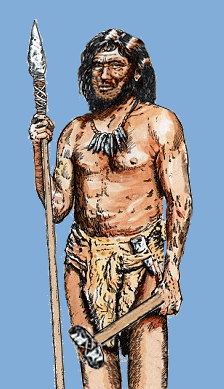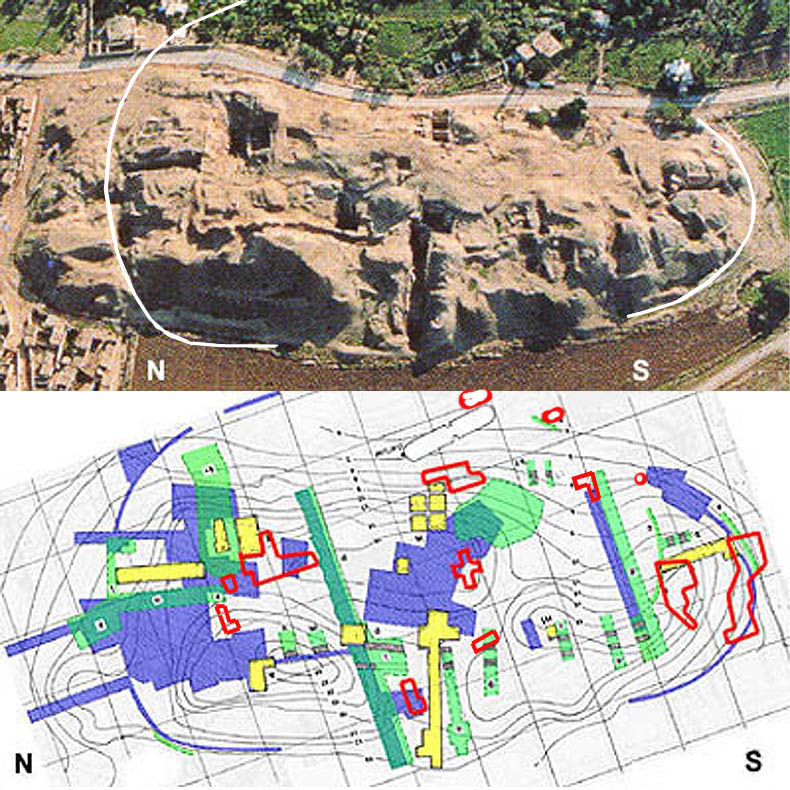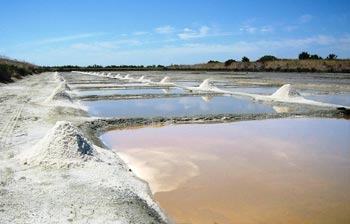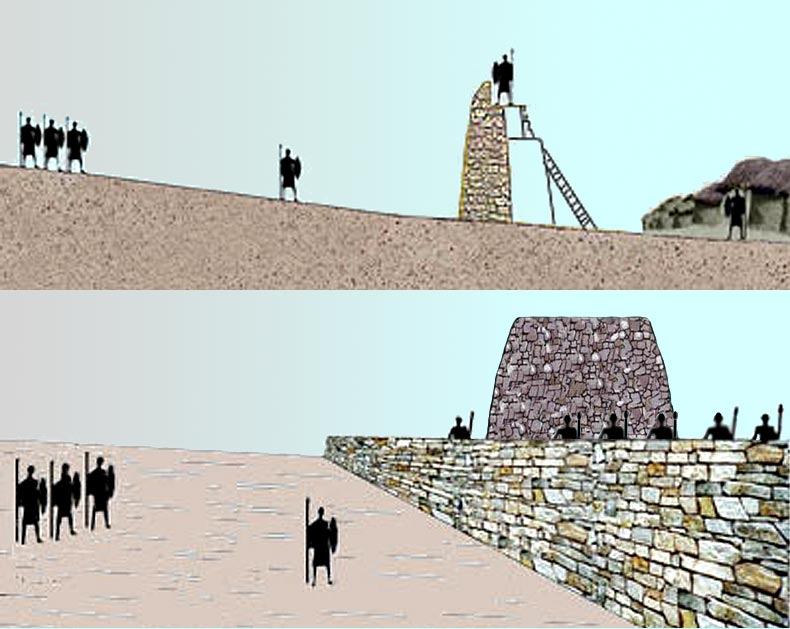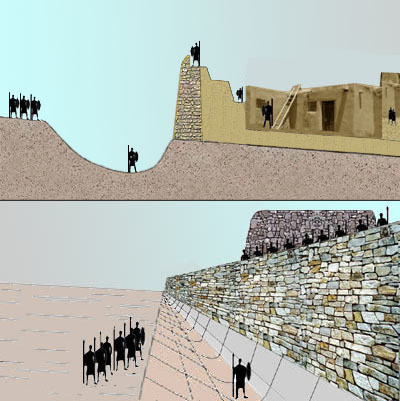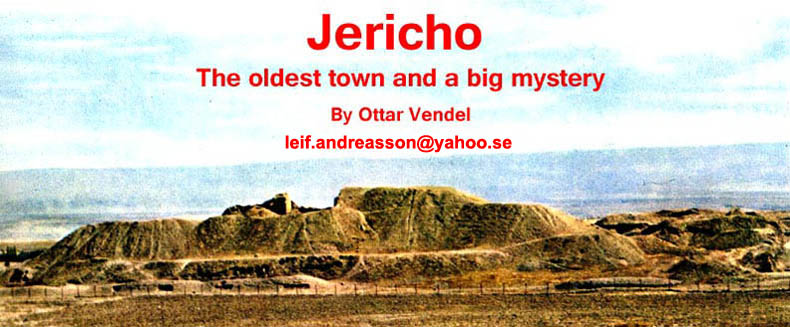
 t the western hillside about 50 km north of the Dead Sea in the Jordan valley in Palestine, lies an old
ruined mound consisting of dry mud, gravel and sun dried bricks. It’s a heap with a silhouette of rounded edges
and it measures about 250 by 120 meters in the direction North to South. Today its highest point
reaches around 25 meters over the plains, bur erosion through rain and wind has flattened it out from a more lofty position. By tradition this is the remain of the Biblical town of Jericho, thought there is no conclusive proof of this, just a tradition. This ruined hill is a so called “tell” (Arabic for hill) and has the local name
Tell-es-Sultan. As far as science knows today (year 2012), this is what remains of the oldest town we know. During seven seasons of archaeological excavations it the 1950s it reveled knowledge about early human civilization that was amazing - huge stone walls from around 10 000 years ago. Nowhere else would anything resembling this be constructed for over 3 000 years.
t the western hillside about 50 km north of the Dead Sea in the Jordan valley in Palestine, lies an old
ruined mound consisting of dry mud, gravel and sun dried bricks. It’s a heap with a silhouette of rounded edges
and it measures about 250 by 120 meters in the direction North to South. Today its highest point
reaches around 25 meters over the plains, bur erosion through rain and wind has flattened it out from a more lofty position. By tradition this is the remain of the Biblical town of Jericho, thought there is no conclusive proof of this, just a tradition. This ruined hill is a so called “tell” (Arabic for hill) and has the local name
Tell-es-Sultan. As far as science knows today (year 2012), this is what remains of the oldest town we know. During seven seasons of archaeological excavations it the 1950s it reveled knowledge about early human civilization that was amazing - huge stone walls from around 10 000 years ago. Nowhere else would anything resembling this be constructed for over 3 000 years.
Still there is an unsolved mystery about what type of surplus the people must have produced. Growing crops in a primitive way to sell and live on, cannot have made the wealth to make huge constructions and feed 1 500 - 2 000 persons. Despite the fact that the climate in those days (9.000 years BC) was warmer and more humid. Hunting and fishing(?) this was too low producing and hazardous to be additional to the low producing farming to make such a gigantic surplus needed to undertake constructions as we find already in the first stages of permanent living. A reasonable theory is that they must have had som kind of goods to trade with to obtain their wealth. A fair guess is that something attractive in the nearby surroundings is the answer. Furhermore, they must have been in a position to have a monopoly on this market sinze to no place in the region has been found matching the age of Jericho not to say its huge walls and settlement. If so this wanted and unique substance is within reach of detection today, just by taking a look at the surroundings. The question remains - what is there to look for? In this editors' mind the answer is clear - salt mines, or traces of shallow artificial ponds designed to extract salt from water by evaporation. This latter way was used by local bedouins as late as in the 1950s. An observation is that in those old days the rainfall was rather heavy compared to today when it's practically zero. The water level of the Dead Sea probably was higher than today. Mining salt would then have taken place on the bottom where salt was deponated since millions of years back. Finding salt harvesting places here under thhe surface today, is very easy because there are many. An obstacle on the other hand is that they are practically unable to date unless tools and other atifacts ar found in an undisturbed position. Up to date (2014) nothing of this kind has been found as the editor knows.
It all started by a flat slightly sloping rock of rather soft limestone covered in places with half a meter of mud. At the east side was the reason for its attraction from animals and humans alike - a well with big amount of fresh water flowing all year long. Drinking, resting and hunting had been going on here likely since the dawn of man, and before permanent living can be traced on the spot a culture deposit with a depth of 4 meters tell that nomads had been living here for thousands of years. 10 000 years ago a huge step was taken when fundaments and then robust round houses made of clay came to be instead of huts of reed and windshields. Just after a few generation at the most came the next step without any developing stage. It was the foundation of a town with a city wall made of stone and a big round watch tower, which till is standing today. From nowhere came the construction of a well planned military defense system, to protect the people of Jericho from invaders from somewhere. Where they brought their skill in stone masonry from is till a question awaiting an answer. The threat from outside was probably rejected at first, but a couple of hundred years later the wall collapsed from reasons unknown. It was rebuilt rather quickly but came down for a second time by the hands of enemies who now took over. A new wall was built a couple of meters outside the location of the first one, and it was thicker and higher, a good 6 meters at least. Just outside it a 3 meter deep moat was cut from the bedrock which was (if it surrounded the town and it probably i did) a huge task made through implements where the hardest was made of stone. Surely this was the deed of others than farmers and hired workers and troops must have played a major part in this gigantic fieldwork. The newcomers had another type of dwellings being square houses often rectangular with sizes up to 5 by 7 meters, often grouped around an open yard. Notably just a fraction of the area from this time has been investigated, and thus general conclusions about types of buildings might have a portion of uncertainty. This early stage of Jericho, when the walls stood on the bedrock, was more or less unknown to science and the public until it was revealed in all its glory during the 1950s. The result was to say the least, stunning. It changed the map of the history of urban man and especially the transition from hunters to primitive farmers. Today it seems clear that another step in human culture came in between these two, at least as for the people of Jericho who likely must have built their wealth upon a new type of income - as traders. Grasping all stages of building activities in Jericho over thousands of years is very hard to do. At least 23 layers of different cultures/trends were found during the excavation in the mid 1950s. Contrary to what some dictionaries etc. on the Internet says, this site has not been continuously inhabited since the start, far from it. The link to the timeline below will visualize this. Modern computers give opportunities to present all phases in an easy-to-understand graphic way, but so far nobody seems to have done so. Since Jericho is on UNESO’s World Heritage list, hopefully a good presentation will come in the near future.  uring the late 1800s a couple of minor excavations at Jericho hill were made, but they were exacuted by amateurs who didn’t understand what they found, and thus made the wrong conclusions, if any. uring the late 1800s a couple of minor excavations at Jericho hill were made, but they were exacuted by amateurs who didn’t understand what they found, and thus made the wrong conclusions, if any. It would take a bit into the 20th century when scholars performed the first planned survey of the place, and it was made by a German/Austrian expedition. The leaders were Ernst Sellin (1867-1946) and Karl Watzinger (1877-1948), and the former had an academic degree not only in archaeology, but in theology as well and furtermore a promotion to priesthood. In three seasons in 1907-1909 and 1911 they made digging all over the hill and cut trenches through the piled up rubble deep into the layers of human traces. They painstakingly recorded the different phases and could make a timetable of historical periods of the settlement. They found several walls from various times and it came to light that the place was probably occupied over most of the area right from the start. This indicated that a group of people came and settled down there at a specific moment in history. By then the place was at most a camp site for nomading hunters in the Jordan valley.
Excavation number two was made by the Englishman John Garstang (1876-1956). Unfortunately he was bound to his Christian beliefs and made the unscientific statement that he should confirm the Bible through his work. He excavated for seven seasons 1930-1936 and nobody was surprised when he declared that he had found the wall which fell just like it said in the Scripture. As for the work covering the older times, he found a lot of old settlements but was not correct in dating finds and layers. He did not publish a final report of his work, just some brief articles and a tiny book. In less than two decades his work would be revieled as a scientific backlash. The next survey took place during the 1950s and was of another standard. During the 15 years following the last digging the technical development of archaeology had made great progress and a scholar from a the new era and generation entered the arena. Her name was Kathleen Kenyon (1906-1978) and she had been born into the trade of archaeology since her father was the chief of the British Museum. In addition to her solid background she had up-to-date skills, like mastering the new method for dating, Carbon 14 (C14), for organic matter. During seven seasons (1952-1958) her work should improve knowledge about human history to an unprecedented level nobody could have foreseen. The final report from this work was published in six thick volumes and is the encyclopedia of ancient Jericho for generations to come. Her method was mainly to dig trenches and gradually remove the finds after a total documentation. This required a great deal of manpower, and the local inhabitants stood for most of the manual labor on the site. Her well documented work is a foundation to value and make conclutions for everyone in all future. Hopefully an additional presentation will come using modern publishing through computorized images and 3D animations. In this way different stages of settlements during 6 000 years of human activities can be understood by anyone. There is also a possibility making a DNA pattern from all human skeletal remains, to detect relationship and origin of all groups of people which have replaced each other on the spot from the earliest times. Most of the bones are not in shape to be detected for DNA but som parts free from contamination (like teeth) should be able to broaden the knowledge. No attempt to do so has come to the authors knowledge. In short: much is yet to be done, but the question is - when and made (and paid) by whom. The text you are reading just now refers to conclusions scientists as a whole do agree upon, free from any religious or political dogma. In broad strokes it describes the bulk of what has come to light up to now (2013), in a time flow where the oldest periods move towards the present. The theory of trading salt is just a possibility not yet proven and thus not rejected. Let's hope for a plesent journey back in time!  hen people first arrived here many thousand of
years ago they found a clay covered flat rock of limestone slightly sloping to the east. Why this rather sterile
plateau attracted humans and animals alike was a very precious gift – a spring with a profuse flow of water which
never dried up. These hunters and gatherers used it as a stop during their circulation in the area seeking for
eatable herbs and game by the water hole. The oldest traces of them are remains of huts and sherds from their tool
making of flint. The implements of wood and bone have decayed through the humidity of the soil. At a spot on the
cliff the cultural layers from these nomads reaches the height of 4 meters and yet in another place at the
northeast this layer is lacking thou it’s probably from the same early period. Instead there is a square area of
natural clay covering the cliff which has been bounded by stones making it a lofty spot 40 cm high when the rest
of the area was dug up to the ground. This does not seem like a house and can therefor possibly be a sanctuary of
some sort, made to praise the spirits who had given them the water. Two of the stones had been bored through with
a diameter of 15 cm, with is a task very difficult, not to say impossible, to have been made using the tiny tools
of hunters. They may have served as foundations to poles in a building which no doubt had been an official structure, probably a shrine of quite impressive measurements. These finds have made it possible to make a fairly accurate reconstruction.
This indicates that advanced stone cutting was known already at this early stage which has been dated to hen people first arrived here many thousand of
years ago they found a clay covered flat rock of limestone slightly sloping to the east. Why this rather sterile
plateau attracted humans and animals alike was a very precious gift – a spring with a profuse flow of water which
never dried up. These hunters and gatherers used it as a stop during their circulation in the area seeking for
eatable herbs and game by the water hole. The oldest traces of them are remains of huts and sherds from their tool
making of flint. The implements of wood and bone have decayed through the humidity of the soil. At a spot on the
cliff the cultural layers from these nomads reaches the height of 4 meters and yet in another place at the
northeast this layer is lacking thou it’s probably from the same early period. Instead there is a square area of
natural clay covering the cliff which has been bounded by stones making it a lofty spot 40 cm high when the rest
of the area was dug up to the ground. This does not seem like a house and can therefor possibly be a sanctuary of
some sort, made to praise the spirits who had given them the water. Two of the stones had been bored through with
a diameter of 15 cm, with is a task very difficult, not to say impossible, to have been made using the tiny tools
of hunters. They may have served as foundations to poles in a building which no doubt had been an official structure, probably a shrine of quite impressive measurements. These finds have made it possible to make a fairly accurate reconstruction.
This indicates that advanced stone cutting was known already at this early stage which has been dated to
 fter what seems to have been a short period of just
300-400 years, the culture of the beehive-people vanishes and the town wall collapsed by lack of maintenance.
This second period without pottery (PPNB) started in 7.500 BC. and should last for another fter what seems to have been a short period of just
300-400 years, the culture of the beehive-people vanishes and the town wall collapsed by lack of maintenance.
This second period without pottery (PPNB) started in 7.500 BC. and should last for another The wealth continued to be very high and making mining for salt at the bottom of the Dead Sea was the likely base of it all. Just beeing self sufficient on grain for baking bread does not seem to be enough, and this might be another sorce to get their wealth. By this surplus labor could be hired to make the enormous defence ring around the town.
Unfortunately no chemical tests of the inner parts of the basins were made, since the wealt of Jericho at that time was explained solely by its rich harvests of grain. Other means were not discussed, or at least not written aboute. An asset it could NOT have been, was meat from cattle breeding, since this part in human history was thousands of years ahead. The inhabitants of Jericho were stone age people using tools made of stone, bone and wood. Liquid was carried in skin sacks or animal bladders etc. and dry goods in wickerwork baskets. Heavy things like stones were probably transported (pulled manually) on sledges. Notably the use of beasts of burden came 2000 years later and the invention of the wheel was over 5000 years ahed! This shift also saw a new type of dwelling and clearly another people (or parts of thier culture) had overtaken the town. If this was carried out by force or if they arrived at an abandoned city, we don't know since remarkabably no weapons suggesting warfare have been found. Their houses were square in shape and the floor now sunken down and coated with polished plaster in the colors red or blue. These types of floors were to be dominant in Jericho for more almost two millennia to come. The walls of the house had no stone foudations and the bricks were of another type - rectangular instead of shaped like a loaf of bread. The roofs had another construction (probably flat) and the span in a big rooms could be a good 6 meters. Outside the houses were open spaces, like yards. Where this new "plastered-floor" people hostile nomads who had overthrown the beehive-people? Not likely nomads at least, because their houses were clearly permanent built and had their origin in a town somewhere else. They were probably also used to stone masonry (or adopted the skill from the masons of Jericho) and another town wall of similar type was erected a couple of meters outside the old fallen one. Another feature was now added and it was totally new type of construction in human history. We can presume that this conquest was made to get hold of the lucrative monopoly of salt which make it the first known war of its kind in history - to dominate a single market and get wealth thru military might and cheap labor.  y the arrival of this group of people (the beehive-culture) a new era began called Pre-Pottery Neolithic A (short: PPNA) which lasted for around 1000 years.
C14 dated at around 8 200 BC and suddenly, without any earlier stages, robust round houses with stone foundations
appear, obviously built for permanent living and not a temporary shelter for hunters. The walls were made of clay
bricks and looked like a loaf of bread, and just about the same size. On the rounded top the maker had pressed
down his thumbs in a row to make a better bounding to the mortar. After a short while, when these houses were still
in use (possibly not more than a couple of hundred years) something extraordinary was made which still to this day
(2012) has not found its counterpart from this old times. y the arrival of this group of people (the beehive-culture) a new era began called Pre-Pottery Neolithic A (short: PPNA) which lasted for around 1000 years.
C14 dated at around 8 200 BC and suddenly, without any earlier stages, robust round houses with stone foundations
appear, obviously built for permanent living and not a temporary shelter for hunters. The walls were made of clay
bricks and looked like a loaf of bread, and just about the same size. On the rounded top the maker had pressed
down his thumbs in a row to make a better bounding to the mortar. After a short while, when these houses were still
in use (possibly not more than a couple of hundred years) something extraordinary was made which still to this day
(2012) has not found its counterpart from this old times.
What can be concluded about their background is that it wasn’t a pastoral one, but an urban, from an older town not yet found. Their round houses like huts had a diameter of 2-3 meters and were possibly roofed with a conical top like a beehive. Wickerwork plus reed and clay was probably material to the walls and roof. At the base a low foundations (c. 0,5 m). The bricks from the house walls on the other hand were of the loaf type, were unique for Jericho and have not been found elsewhere. The impressive wall made of natural stone with clay as mortar. The stone size was not more than a one-man-lift. They were taken from the nearby mountain hill and carried in a unknown way, probably dragged (by people) on sledges etc. At this point no beasts of burden existed and the wheel should not be invented until 5.000 years later! The wall was built directly upon the bedrock and is presumed to have been encircling the whole town, a distance of a good 700 meters. At one point a solid tower was built into the wall at the west side with the dimensions 11 meters in hight and 7-10 meters in diameter. Its purpose has been discussed and as a military supplement to the defense wall it would have been unnecessary clumsy and rather useless. I has a staircase from the inside (facing the town) leading to the top, the oldest of its kind found so far. The remains of the wall was standing at the investigated point up to 3,2 meters, thinner at the top and 1.8 meters thick at the base. An estimation is that it once stood around 5-6 meters over the surroundings and protected the city folks, but from what or who? Scholars have put forward that it might have been a barrier against floods of muddy water from the Jordan river, and this was reality 10 000 ago, when the climate in the area wasn’t as dry as today. If so, this could have been a positive side affect for its main use, a fortification against other people trying to conquer them and robbing the wealth of their town. The wealth was the food which they produced in their fields, and surely an additional asset of great value - salt. Here we have the first example of well organized centralized leadership. In addition an advanced building techniques which must had developed over a long period of time. Where did they come from? From far away or within "walking distance" in the vicinity? The group (several hundreds at least) has left no traces to indicate their original home, but some place in the neighboring Near East is of course plausible where wild wheat and rye were growing, and even Jordan Valley itself might be the answer. The place must have had just the facilities they found at Jericho – water, fertile soil and stone easy to handle for constructions. We must keep in mind this was a group of Stone Age people who didn’t know metals or even how to make pots and plates from clay. Their implement were just made of stone, bone and wood. Their clothing were hides and reed, and domesticated animals (and building other towns) lay 3.000 years in the future. Everything was carried in baskets and sacks or dragged on sledges sinze the wheel wasn't invented for another 5.000 years. Yet they made grand construction designs which are still standing today after 10,000 years!
The first city dwellers had now built a good 600 meter long and 6 meter high wall of natural stone around their town. How did they managed to forfill such a great task? The size of this great construction indicate that the arrival to the spot was NOT spontaneous but a planned migration of a group of people who knew they could live and support themselves in their new location. If they were related to the dwellers who already lived there in rather solid huts, we do not know. When their fortified city was compleated the decay of the walls seems to have started soon and during the next century or so it fell down or at least was demolished perhaps thru weather conditions (heavy rain) and lack of maintenance. It was repaired and set to order once again, but within a time span of around 200 years it should be demolished by a conquering people. If the inhabitants were kiled, taken captive, were assimilated (or present) when the newcomers arrived, we do not know. We have reason to believe that they had good knowledge of each other and the first wall bas obviously built to protect from invasions like the one which now had occured. The invaders were by no means inferior to the Jericho dwellers as for masonry, or learned very fast, because they improved the defence structure right away. They erected a new wall a couple of meters outside the old one and in addition made onother remarkable defence structure – a 3 meter deep and 9 meter wide moat cut down into the limestone bedrock! Thousand of cubic meters of stone was removed by just using tools made of wood, bone and stone. How this was made in practice is yet to be found out, but theories about using clubs to split out the rock after cracking it up by fire has been put forward. Traces of ashes on the debris from this work has not been detected during the archaeology diggings which reached this level. Neither have any practical experiments been made on this matter, which raises a lot of questions of which some are quite bevildering. How could these farmes (and probably also traders) finance such a huge exploit? Thru slaves, hired hands or what? We do not know, and this is the thrilling point in the earliest history of Jericho – the step in human transition from namadism to producers of food of thier own.  any theories have been put forward since the tower was found in the 1950s by the British archaeologist Kathleen Kenyon. She performed seven seasons of excavation at Jericho 1952-1958. She was a very skilled and experienced scientist using the latest methods of the trade. One of them was C14 dating which showed the astonishing age of the oldest finds. All earlier timelines of remains resembling big villages or towns were pushed back thousands of years.
What was found was a town with huge stone walls. The earliest at least six meters in height. In addition a big tower 11 m in height and 7 meters wide, entirely of stone. Furthermore, a staircase in its centre going to the top from en entrance a couple of metres from the ground. any theories have been put forward since the tower was found in the 1950s by the British archaeologist Kathleen Kenyon. She performed seven seasons of excavation at Jericho 1952-1958. She was a very skilled and experienced scientist using the latest methods of the trade. One of them was C14 dating which showed the astonishing age of the oldest finds. All earlier timelines of remains resembling big villages or towns were pushed back thousands of years.
What was found was a town with huge stone walls. The earliest at least six meters in height. In addition a big tower 11 m in height and 7 meters wide, entirely of stone. Furthermore, a staircase in its centre going to the top from en entrance a couple of metres from the ground. Kenyon recognised these as part of a military defence system, made by the inhabitants to protect the town from invaders. Since they themselves obviously came from somewhere with an advanced knowledge of stone masonry and central leadership, this was probably the neighbours to be protected from. 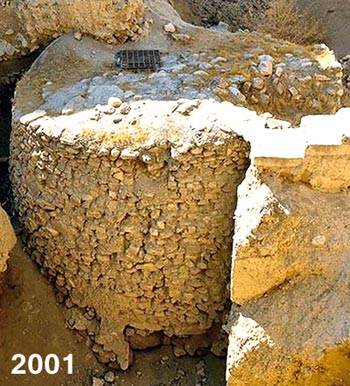 After around 300 years the wall was demolished, either by erosion or invaders, and another one, even higher, was built a couple of meters outside the original one. The tower was altered by adding its thickness by a skin wall. In addition a entire new construction in human history was made - a dry moat outside the wall, three meters in depth by the wall and nine meters wide. This was cut down into the bedrock of limestone and probably surrounded the whole city. Kenyon proposed that this gigantic work was made by burning wood on the surface, poring water to make it crackle and pound the stone with wooden clubs. A practical proof to test this theory has not been undertaken as far as this editor knows.
After around 300 years the wall was demolished, either by erosion or invaders, and another one, even higher, was built a couple of meters outside the original one. The tower was altered by adding its thickness by a skin wall. In addition a entire new construction in human history was made - a dry moat outside the wall, three meters in depth by the wall and nine meters wide. This was cut down into the bedrock of limestone and probably surrounded the whole city. Kenyon proposed that this gigantic work was made by burning wood on the surface, poring water to make it crackle and pound the stone with wooden clubs. A practical proof to test this theory has not been undertaken as far as this editor knows. With time other suggestion and questions rose, such as how did the Jericho dwellers create such a big surplus of free time, to be able to, beside their toiling in the fields, create all this. If they did not do it themselves, how could they pay anyone to do it? and if so paying with what? and who were the skilled laborers which must have been quite a few? An early suggestion was that the moat was for protection from floods coming from the mountains during the wet season. Still today some scholars promote this theory, some arguing that no weapons from attackers has ever been found inside or just outside the city walls. This argument by lacking of evidence can be tricky to promote all the way, because this moat encircles the town just like the wall(s). If the flood of muddy water came from the nearby mountains in the west, there would have been no use for a moat at the other sides where the water just would have passed by. An opinion rather agreed upon is that the tower would have no military purpose at all. As a watchtower it was clumsy and expensive/time consuming to build and a wooden tower would have been much better for just scouting the area outsde the town. Theories that it was a building for religious reasons or/and astronomy observations has been put forward, but has not impressed this editor so far. During the following long period of a good 1.500 years there were more than a dozen building periods. The town inside the walls constantly grew higher when new houses were built upon the rubble of the old ones. New walls came to be as well, (in all a dozen have been detected), and in the next phase a sloping plastered side (rampart) was built from the top down to the field level (drawing below) to make hostile access difficult. By the end of this none-pottery stone age the city had reached 14 meters above the cliff upon which the first people once had settled down. From the surrounding fields it looked like, and was, a fortress on top of an artificial hill. By this the "real" Stone Age was ending though it would take thousands of years before metals came into use. Until then other great improvements were made in living conditions by domestication of animals and by that get meat and milk. 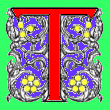 he next step for the cultural development was
the arrival of pottery in around 6 000 BC. he next step for the cultural development was
the arrival of pottery in around 6 000 BC. It came to Jericho with a new people entering the town from the north. They had a fully developed ceramic tradition in their baggage and also another type of flint tools. As this advance came to town a cultural reduction was also visible. The newcomers found a deserted ruined city which had been withot inhabitants for almos 500 years. A remarkable fact is that they have not left any well built houses. Nor have they left traces of a city-life with public buildings like temples or a new wall for their protection.
During Garstang’s excavation some artefacts of human shape came to light under, what was thought to be the time of these first pottery people. Today we know that it more likely was during the last period of PPNB around 6.500 BC. It was a statuette of clay with a core of straw probably showing a god, since beard has been added by ink to the plastered surface. It was 2.5 cm thick and had traces of some sort of headgear (left in picture below). Human skulls coated with plaster and modeled faces (right in picture below) have been found under the floors in the houses. This custom was wide spread in the Middle East at the time. Later cemeteries were made outside the town with tombs which were igloo-shaped chambers 2-4 meters down the bedrock, reachable through a round or square vertical shaft. Some periods only one person was interred in each tomb and in others they were collective with successive burials for families.
The same puzzle goes for decorations and depictions of any kind except for the patterns on pottery, which were imported ideas. Were the inhabitants of old Jericho a hard working joyless group of peasants without fantasy or emotions they liked to share? We don't know. Since there is around 90 % of the area from the PP-periods left to be investigated, there is hope to make finds similar to those found in other places of the Jordan Valley from the same early period. Art of any kind is clearly a product of leasure time, which the Jericho inhabitants must have had. When the harvest was made people had time over for relaxation, feasting and rituals, normally. Thus we cannot tell why the dwellers of Jericho were (as we know) so plain and materialistic. Did they concentrate merely on producing food and defending themselves by reinforcing the town wall, and had a Spartan military view of life? Weapons to support this last theory has not been found, and no heavy tools to work the soil for that matter. A summary of what scholars today know about their religion and other beliefs, is hard to grip and purely guesswork. The male head with a beard painted and the exceptionally fine sculptured skulls tell us they were artistic at least in venerating gods an ancestors. They probably worshipped gods and goddesses of fertility to get a good harvest, besides a slightly older cult for good luck in hunting. Notable is that remnants from the contemporary not fortified site Abu Hureyra, further up north i today's Syria, shows a similar absence of art. At the same time the cave living people in Europe showed astonishing skills in artistic trades like sculpturing (mostly in bone) and rock painting. |
